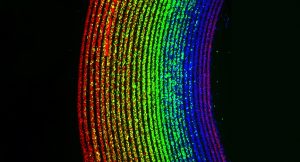
The technique, known as RIFLE – rotational internal flow layer engineering – enables the construction of separate layers down to one cell thick. RIFLE technology can be used to create human-layered tubular tissue for use in the development of new medicines and investigation of disease mechanisms, ultimately reducing the need to use animals in experiments.
Application
The device can be used to generate tubular tissue using human cells and bioink.
Development Status
The RIFLE development process is complete. A licensee will need to optimise the technique for the generation of their specific tissue of interest
IP Status
Commercial Offering
Licensing or collaborative research
Opportunity
RIFLE is a low-cost and fast bio-fabrication method, which can work to a very small scale and provides a high-resolution alternative to 3D printing and other bio-fabrication methods. The technique is used to generate layered tissue from human cells and proteins. Theoretically, the RIFLE technique is compatible with all cells and proteins to generate bespoke tissues for your research.
Technology
The technique involves injecting a small volume of liquid-containing cells into a tube rotating at high speed – up to 9000rpm. The speed of the rotation causes the cells to distribute evenly across the internal surface of the tube, with higher speeds resulting in thinner layers. When this process is repeated, it builds up cell layers to create a tubular structure made of different, distinct layers, with a high density of cells. To date a number of cells and bioinks have been used to form tissue using the RIFLE technique, including ureteric cells, vascular cells and collagen.
Benefits
Publications
Holland, I., Shu, W., & Davies, J. A. (2023). Stratified tissue biofabrication by rotational internal flow layer engineering. Biofabrication, 15(4), 045003.
Quote: TEC1104445

RIFLE, an innovative technology that creates ultra-thin layers of human cells in tube-like structures, could spur the development of lifelike blood vessels and intestines in the lab.

Senior Technology Transfer Executive
College of Science and Engineering
College of Medicine and Veterinary Medicine